Comparative Analysis of Marketing Mix Strategies: Dove and Sure Brands
VerifiedAdded on 2023/01/12
|8
|2135
|38
Report
AI Summary
This report provides a comprehensive analysis of the marketing mix, focusing on the brands Dove and Sure. It begins with an introduction to the 4 Ps of the marketing mix: product, price, place, and promotion. The report then examines the effectiveness of each element within the context of Dove and Sure, highlighting their respective strategies and how they cater to their target markets. Furthermore, the report delves into the STP (Segmentation, Targeting, and Positioning) marketing planning process, demonstrating how Dove and Sure segment their markets, target specific consumer groups, and position their products within the competitive landscape. The report concludes by summarizing the key findings and emphasizing the importance of the marketing mix in developing and implementing effective marketing strategies, supported by references to relevant academic sources.
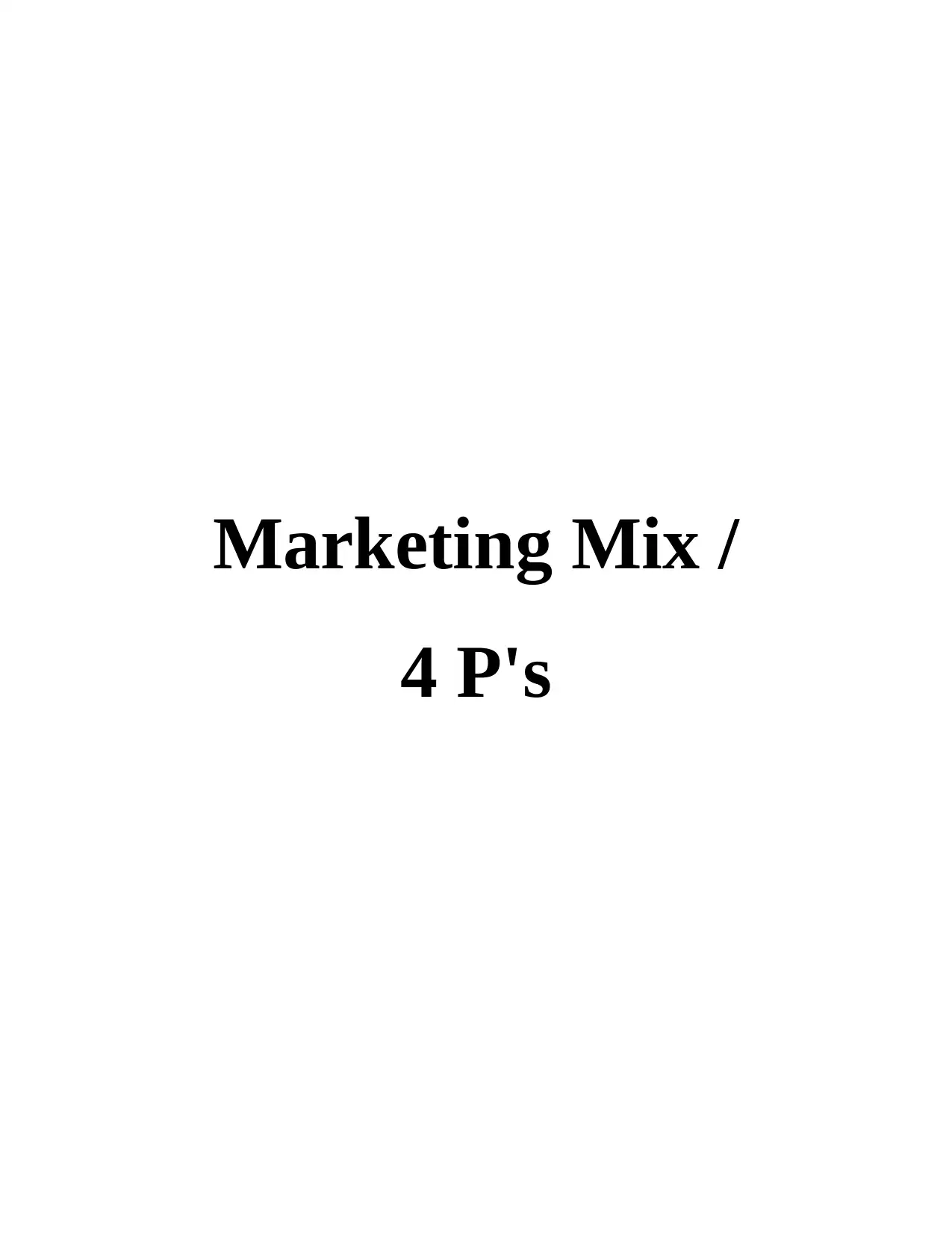
Marketing Mix /
4 P's
4 P's
Paraphrase This Document
Need a fresh take? Get an instant paraphrase of this document with our AI Paraphraser
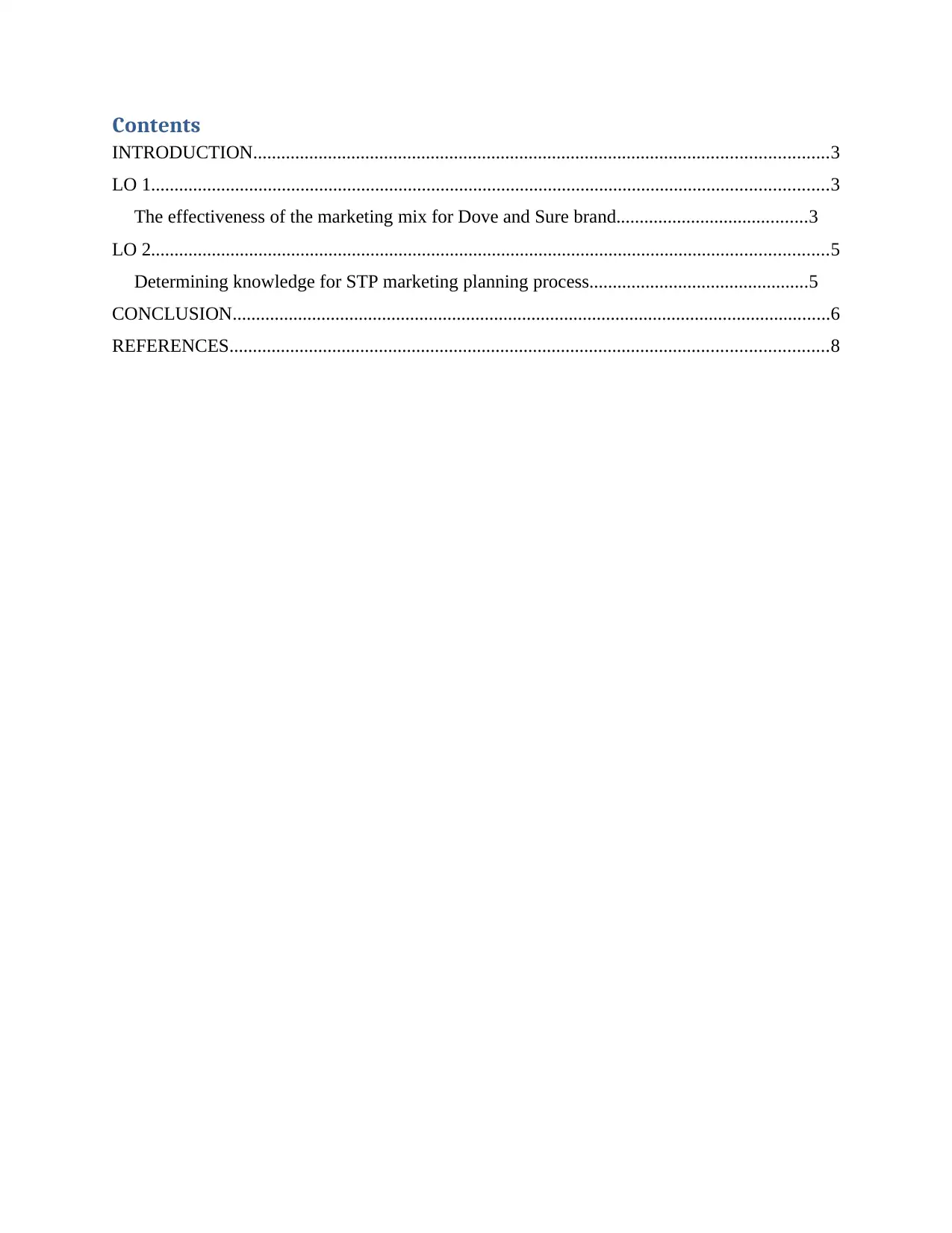
Contents
INTRODUCTION...........................................................................................................................3
LO 1.................................................................................................................................................3
The effectiveness of the marketing mix for Dove and Sure brand.........................................3
LO 2.................................................................................................................................................5
Determining knowledge for STP marketing planning process...............................................5
CONCLUSION................................................................................................................................6
REFERENCES................................................................................................................................8
INTRODUCTION...........................................................................................................................3
LO 1.................................................................................................................................................3
The effectiveness of the marketing mix for Dove and Sure brand.........................................3
LO 2.................................................................................................................................................5
Determining knowledge for STP marketing planning process...............................................5
CONCLUSION................................................................................................................................6
REFERENCES................................................................................................................................8
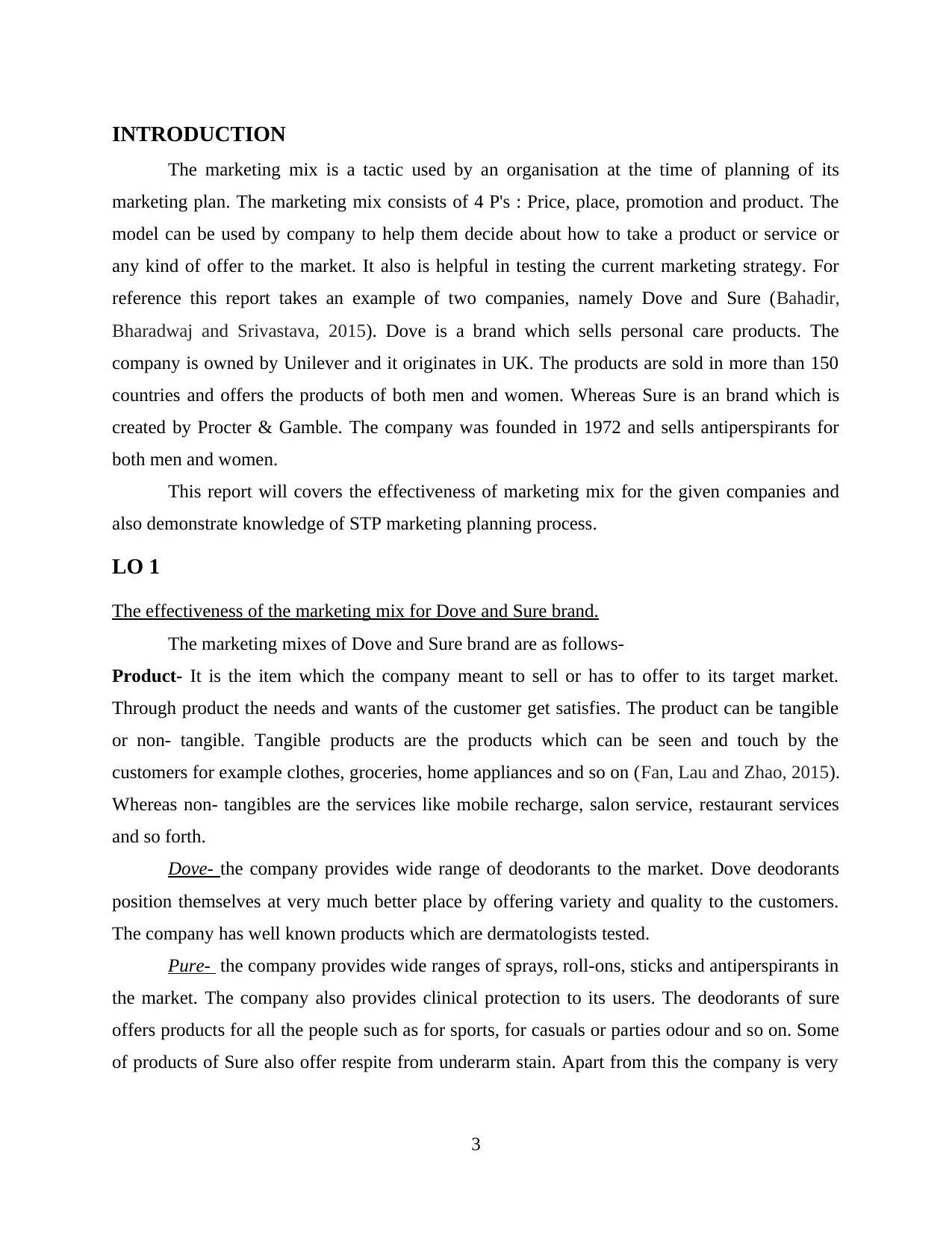
INTRODUCTION
The marketing mix is a tactic used by an organisation at the time of planning of its
marketing plan. The marketing mix consists of 4 P's : Price, place, promotion and product. The
model can be used by company to help them decide about how to take a product or service or
any kind of offer to the market. It also is helpful in testing the current marketing strategy. For
reference this report takes an example of two companies, namely Dove and Sure (Bahadir,
Bharadwaj and Srivastava, 2015). Dove is a brand which sells personal care products. The
company is owned by Unilever and it originates in UK. The products are sold in more than 150
countries and offers the products of both men and women. Whereas Sure is an brand which is
created by Procter & Gamble. The company was founded in 1972 and sells antiperspirants for
both men and women.
This report will covers the effectiveness of marketing mix for the given companies and
also demonstrate knowledge of STP marketing planning process.
LO 1
The effectiveness of the marketing mix for Dove and Sure brand.
The marketing mixes of Dove and Sure brand are as follows-
Product- It is the item which the company meant to sell or has to offer to its target market.
Through product the needs and wants of the customer get satisfies. The product can be tangible
or non- tangible. Tangible products are the products which can be seen and touch by the
customers for example clothes, groceries, home appliances and so on (Fan, Lau and Zhao, 2015).
Whereas non- tangibles are the services like mobile recharge, salon service, restaurant services
and so forth.
Dove- the company provides wide range of deodorants to the market. Dove deodorants
position themselves at very much better place by offering variety and quality to the customers.
The company has well known products which are dermatologists tested.
Pure- the company provides wide ranges of sprays, roll-ons, sticks and antiperspirants in
the market. The company also provides clinical protection to its users. The deodorants of sure
offers products for all the people such as for sports, for casuals or parties odour and so on. Some
of products of Sure also offer respite from underarm stain. Apart from this the company is very
3
The marketing mix is a tactic used by an organisation at the time of planning of its
marketing plan. The marketing mix consists of 4 P's : Price, place, promotion and product. The
model can be used by company to help them decide about how to take a product or service or
any kind of offer to the market. It also is helpful in testing the current marketing strategy. For
reference this report takes an example of two companies, namely Dove and Sure (Bahadir,
Bharadwaj and Srivastava, 2015). Dove is a brand which sells personal care products. The
company is owned by Unilever and it originates in UK. The products are sold in more than 150
countries and offers the products of both men and women. Whereas Sure is an brand which is
created by Procter & Gamble. The company was founded in 1972 and sells antiperspirants for
both men and women.
This report will covers the effectiveness of marketing mix for the given companies and
also demonstrate knowledge of STP marketing planning process.
LO 1
The effectiveness of the marketing mix for Dove and Sure brand.
The marketing mixes of Dove and Sure brand are as follows-
Product- It is the item which the company meant to sell or has to offer to its target market.
Through product the needs and wants of the customer get satisfies. The product can be tangible
or non- tangible. Tangible products are the products which can be seen and touch by the
customers for example clothes, groceries, home appliances and so on (Fan, Lau and Zhao, 2015).
Whereas non- tangibles are the services like mobile recharge, salon service, restaurant services
and so forth.
Dove- the company provides wide range of deodorants to the market. Dove deodorants
position themselves at very much better place by offering variety and quality to the customers.
The company has well known products which are dermatologists tested.
Pure- the company provides wide ranges of sprays, roll-ons, sticks and antiperspirants in
the market. The company also provides clinical protection to its users. The deodorants of sure
offers products for all the people such as for sports, for casuals or parties odour and so on. Some
of products of Sure also offer respite from underarm stain. Apart from this the company is very
3
⊘ This is a preview!⊘
Do you want full access?
Subscribe today to unlock all pages.

Trusted by 1+ million students worldwide
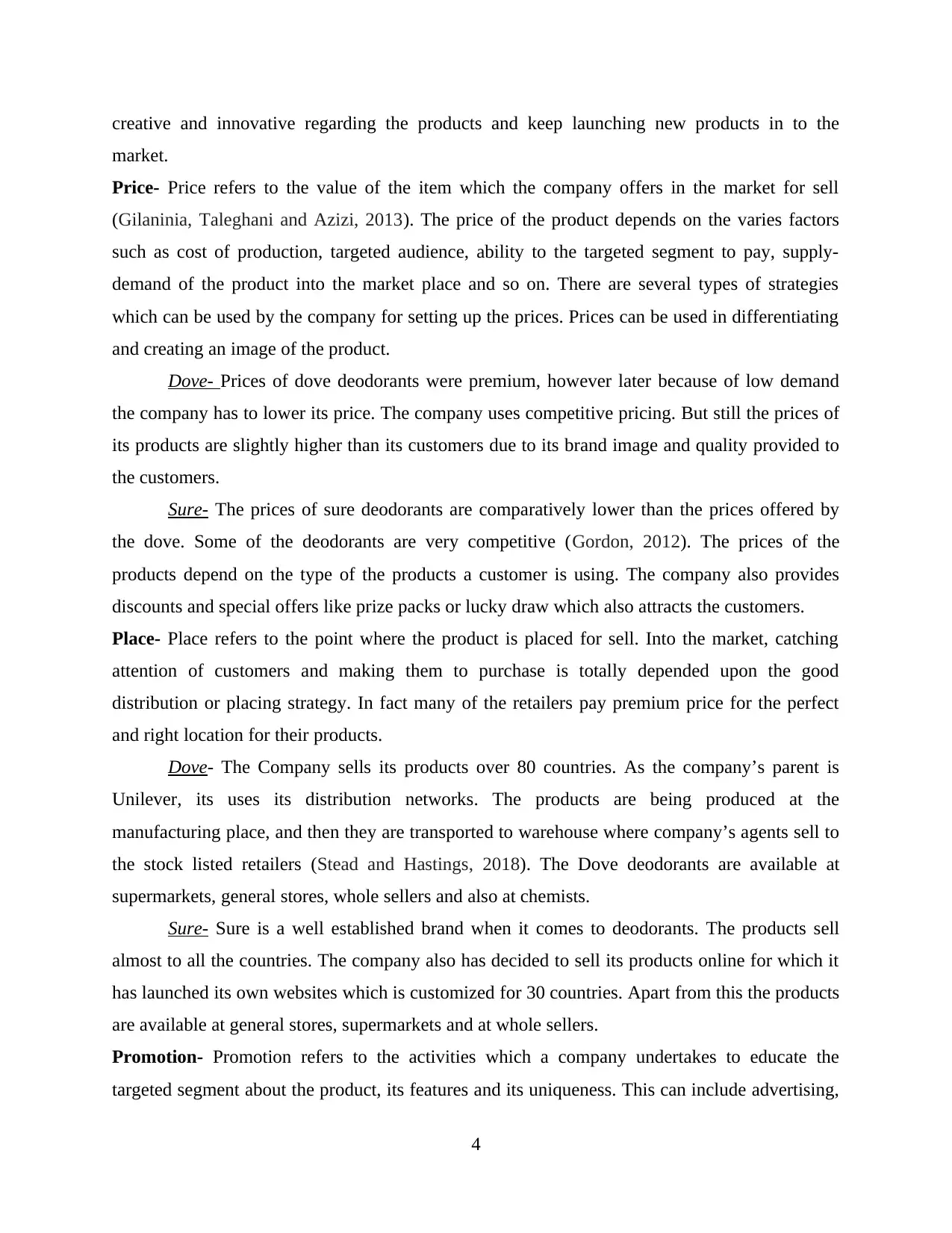
creative and innovative regarding the products and keep launching new products in to the
market.
Price- Price refers to the value of the item which the company offers in the market for sell
(Gilaninia, Taleghani and Azizi, 2013). The price of the product depends on the varies factors
such as cost of production, targeted audience, ability to the targeted segment to pay, supply-
demand of the product into the market place and so on. There are several types of strategies
which can be used by the company for setting up the prices. Prices can be used in differentiating
and creating an image of the product.
Dove- Prices of dove deodorants were premium, however later because of low demand
the company has to lower its price. The company uses competitive pricing. But still the prices of
its products are slightly higher than its customers due to its brand image and quality provided to
the customers.
Sure- The prices of sure deodorants are comparatively lower than the prices offered by
the dove. Some of the deodorants are very competitive (Gordon, 2012). The prices of the
products depend on the type of the products a customer is using. The company also provides
discounts and special offers like prize packs or lucky draw which also attracts the customers.
Place- Place refers to the point where the product is placed for sell. Into the market, catching
attention of customers and making them to purchase is totally depended upon the good
distribution or placing strategy. In fact many of the retailers pay premium price for the perfect
and right location for their products.
Dove- The Company sells its products over 80 countries. As the company’s parent is
Unilever, its uses its distribution networks. The products are being produced at the
manufacturing place, and then they are transported to warehouse where company’s agents sell to
the stock listed retailers (Stead and Hastings, 2018). The Dove deodorants are available at
supermarkets, general stores, whole sellers and also at chemists.
Sure- Sure is a well established brand when it comes to deodorants. The products sell
almost to all the countries. The company also has decided to sell its products online for which it
has launched its own websites which is customized for 30 countries. Apart from this the products
are available at general stores, supermarkets and at whole sellers.
Promotion- Promotion refers to the activities which a company undertakes to educate the
targeted segment about the product, its features and its uniqueness. This can include advertising,
4
market.
Price- Price refers to the value of the item which the company offers in the market for sell
(Gilaninia, Taleghani and Azizi, 2013). The price of the product depends on the varies factors
such as cost of production, targeted audience, ability to the targeted segment to pay, supply-
demand of the product into the market place and so on. There are several types of strategies
which can be used by the company for setting up the prices. Prices can be used in differentiating
and creating an image of the product.
Dove- Prices of dove deodorants were premium, however later because of low demand
the company has to lower its price. The company uses competitive pricing. But still the prices of
its products are slightly higher than its customers due to its brand image and quality provided to
the customers.
Sure- The prices of sure deodorants are comparatively lower than the prices offered by
the dove. Some of the deodorants are very competitive (Gordon, 2012). The prices of the
products depend on the type of the products a customer is using. The company also provides
discounts and special offers like prize packs or lucky draw which also attracts the customers.
Place- Place refers to the point where the product is placed for sell. Into the market, catching
attention of customers and making them to purchase is totally depended upon the good
distribution or placing strategy. In fact many of the retailers pay premium price for the perfect
and right location for their products.
Dove- The Company sells its products over 80 countries. As the company’s parent is
Unilever, its uses its distribution networks. The products are being produced at the
manufacturing place, and then they are transported to warehouse where company’s agents sell to
the stock listed retailers (Stead and Hastings, 2018). The Dove deodorants are available at
supermarkets, general stores, whole sellers and also at chemists.
Sure- Sure is a well established brand when it comes to deodorants. The products sell
almost to all the countries. The company also has decided to sell its products online for which it
has launched its own websites which is customized for 30 countries. Apart from this the products
are available at general stores, supermarkets and at whole sellers.
Promotion- Promotion refers to the activities which a company undertakes to educate the
targeted segment about the product, its features and its uniqueness. This can include advertising,
4
Paraphrase This Document
Need a fresh take? Get an instant paraphrase of this document with our AI Paraphraser
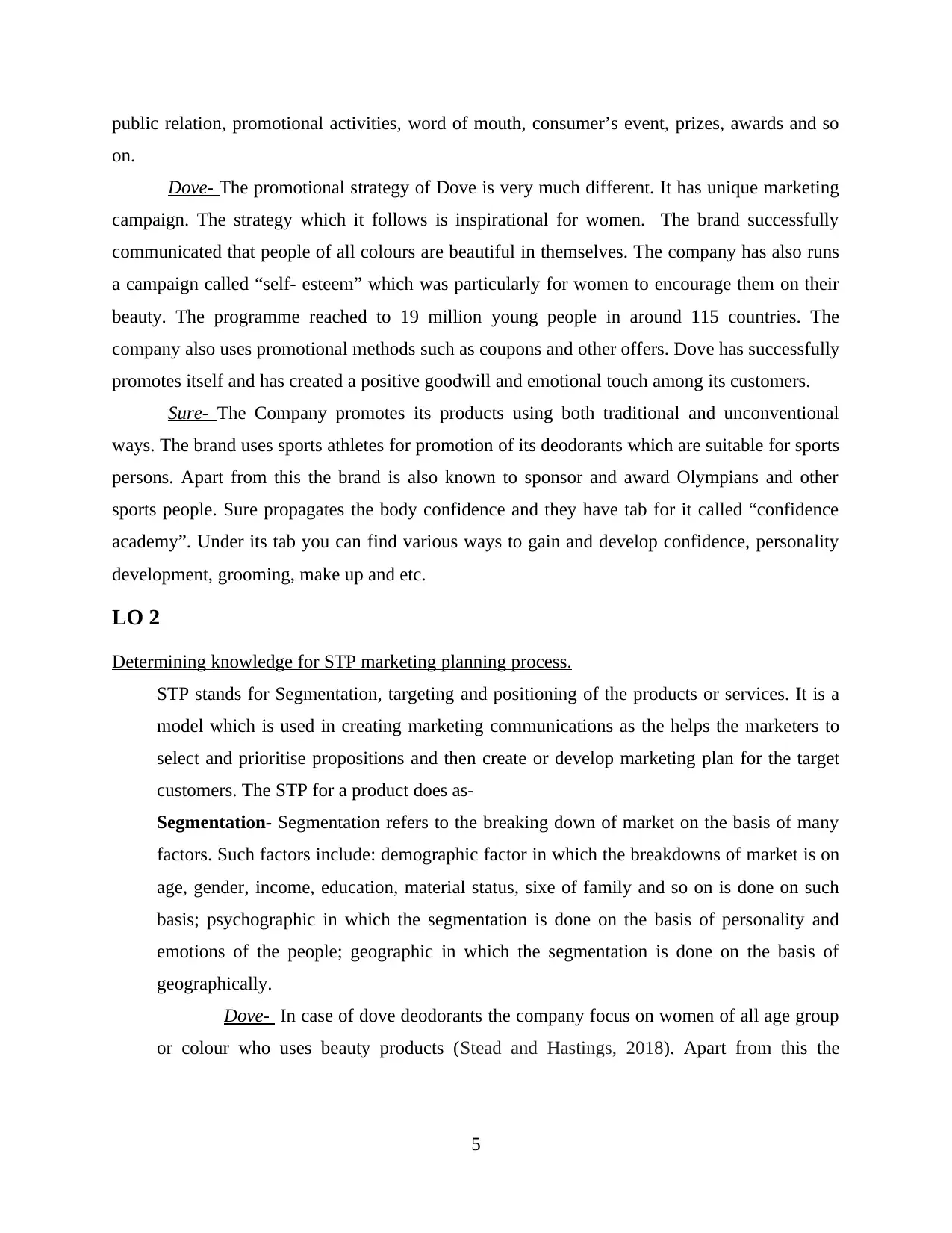
public relation, promotional activities, word of mouth, consumer’s event, prizes, awards and so
on.
Dove- The promotional strategy of Dove is very much different. It has unique marketing
campaign. The strategy which it follows is inspirational for women. The brand successfully
communicated that people of all colours are beautiful in themselves. The company has also runs
a campaign called “self- esteem” which was particularly for women to encourage them on their
beauty. The programme reached to 19 million young people in around 115 countries. The
company also uses promotional methods such as coupons and other offers. Dove has successfully
promotes itself and has created a positive goodwill and emotional touch among its customers.
Sure- The Company promotes its products using both traditional and unconventional
ways. The brand uses sports athletes for promotion of its deodorants which are suitable for sports
persons. Apart from this the brand is also known to sponsor and award Olympians and other
sports people. Sure propagates the body confidence and they have tab for it called “confidence
academy”. Under its tab you can find various ways to gain and develop confidence, personality
development, grooming, make up and etc.
LO 2
Determining knowledge for STP marketing planning process.
STP stands for Segmentation, targeting and positioning of the products or services. It is a
model which is used in creating marketing communications as the helps the marketers to
select and prioritise propositions and then create or develop marketing plan for the target
customers. The STP for a product does as-
Segmentation- Segmentation refers to the breaking down of market on the basis of many
factors. Such factors include: demographic factor in which the breakdowns of market is on
age, gender, income, education, material status, sixe of family and so on is done on such
basis; psychographic in which the segmentation is done on the basis of personality and
emotions of the people; geographic in which the segmentation is done on the basis of
geographically.
Dove- In case of dove deodorants the company focus on women of all age group
or colour who uses beauty products (Stead and Hastings, 2018). Apart from this the
5
on.
Dove- The promotional strategy of Dove is very much different. It has unique marketing
campaign. The strategy which it follows is inspirational for women. The brand successfully
communicated that people of all colours are beautiful in themselves. The company has also runs
a campaign called “self- esteem” which was particularly for women to encourage them on their
beauty. The programme reached to 19 million young people in around 115 countries. The
company also uses promotional methods such as coupons and other offers. Dove has successfully
promotes itself and has created a positive goodwill and emotional touch among its customers.
Sure- The Company promotes its products using both traditional and unconventional
ways. The brand uses sports athletes for promotion of its deodorants which are suitable for sports
persons. Apart from this the brand is also known to sponsor and award Olympians and other
sports people. Sure propagates the body confidence and they have tab for it called “confidence
academy”. Under its tab you can find various ways to gain and develop confidence, personality
development, grooming, make up and etc.
LO 2
Determining knowledge for STP marketing planning process.
STP stands for Segmentation, targeting and positioning of the products or services. It is a
model which is used in creating marketing communications as the helps the marketers to
select and prioritise propositions and then create or develop marketing plan for the target
customers. The STP for a product does as-
Segmentation- Segmentation refers to the breaking down of market on the basis of many
factors. Such factors include: demographic factor in which the breakdowns of market is on
age, gender, income, education, material status, sixe of family and so on is done on such
basis; psychographic in which the segmentation is done on the basis of personality and
emotions of the people; geographic in which the segmentation is done on the basis of
geographically.
Dove- In case of dove deodorants the company focus on women of all age group
or colour who uses beauty products (Stead and Hastings, 2018). Apart from this the
5
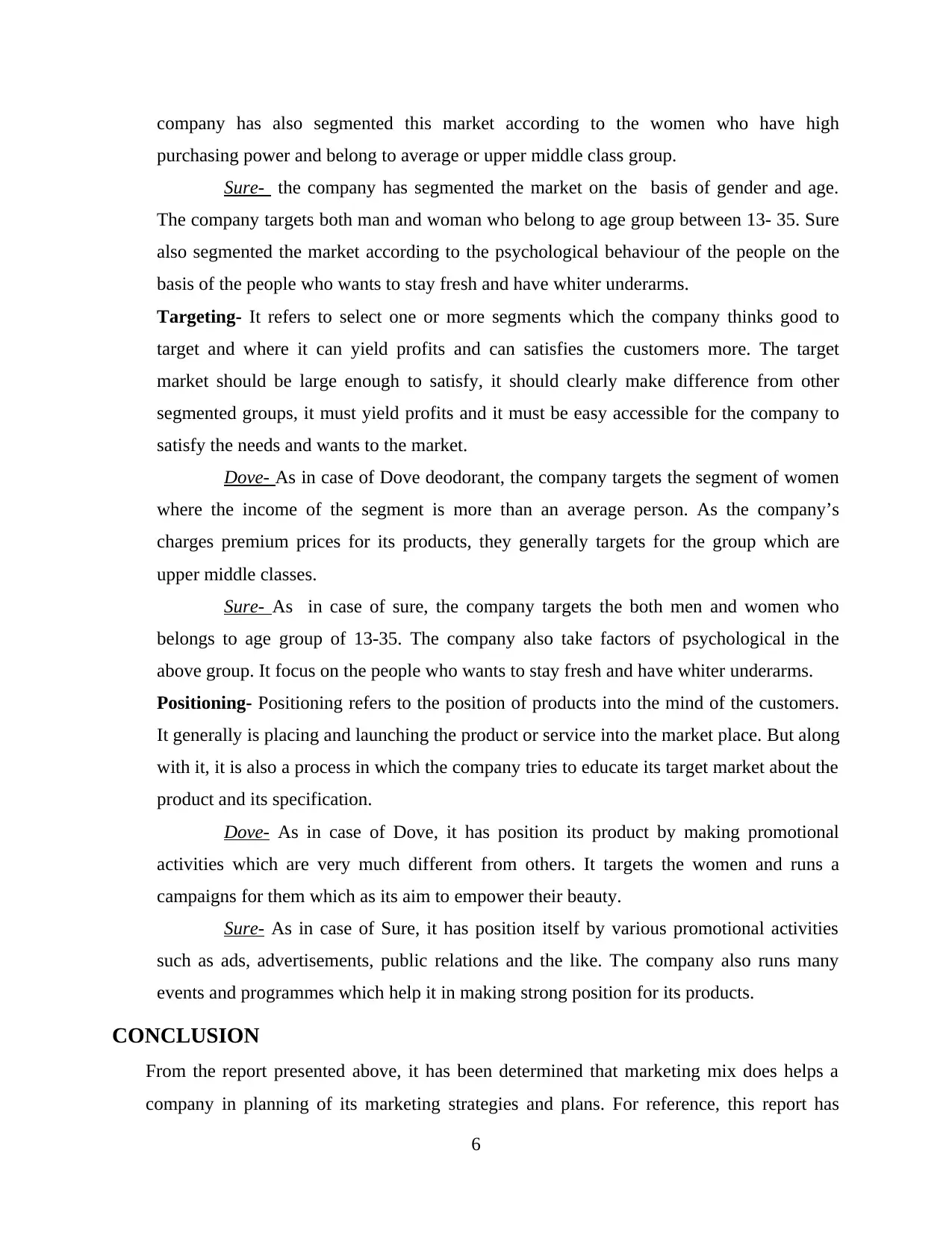
company has also segmented this market according to the women who have high
purchasing power and belong to average or upper middle class group.
Sure- the company has segmented the market on the basis of gender and age.
The company targets both man and woman who belong to age group between 13- 35. Sure
also segmented the market according to the psychological behaviour of the people on the
basis of the people who wants to stay fresh and have whiter underarms.
Targeting- It refers to select one or more segments which the company thinks good to
target and where it can yield profits and can satisfies the customers more. The target
market should be large enough to satisfy, it should clearly make difference from other
segmented groups, it must yield profits and it must be easy accessible for the company to
satisfy the needs and wants to the market.
Dove- As in case of Dove deodorant, the company targets the segment of women
where the income of the segment is more than an average person. As the company’s
charges premium prices for its products, they generally targets for the group which are
upper middle classes.
Sure- As in case of sure, the company targets the both men and women who
belongs to age group of 13-35. The company also take factors of psychological in the
above group. It focus on the people who wants to stay fresh and have whiter underarms.
Positioning- Positioning refers to the position of products into the mind of the customers.
It generally is placing and launching the product or service into the market place. But along
with it, it is also a process in which the company tries to educate its target market about the
product and its specification.
Dove- As in case of Dove, it has position its product by making promotional
activities which are very much different from others. It targets the women and runs a
campaigns for them which as its aim to empower their beauty.
Sure- As in case of Sure, it has position itself by various promotional activities
such as ads, advertisements, public relations and the like. The company also runs many
events and programmes which help it in making strong position for its products.
CONCLUSION
From the report presented above, it has been determined that marketing mix does helps a
company in planning of its marketing strategies and plans. For reference, this report has
6
purchasing power and belong to average or upper middle class group.
Sure- the company has segmented the market on the basis of gender and age.
The company targets both man and woman who belong to age group between 13- 35. Sure
also segmented the market according to the psychological behaviour of the people on the
basis of the people who wants to stay fresh and have whiter underarms.
Targeting- It refers to select one or more segments which the company thinks good to
target and where it can yield profits and can satisfies the customers more. The target
market should be large enough to satisfy, it should clearly make difference from other
segmented groups, it must yield profits and it must be easy accessible for the company to
satisfy the needs and wants to the market.
Dove- As in case of Dove deodorant, the company targets the segment of women
where the income of the segment is more than an average person. As the company’s
charges premium prices for its products, they generally targets for the group which are
upper middle classes.
Sure- As in case of sure, the company targets the both men and women who
belongs to age group of 13-35. The company also take factors of psychological in the
above group. It focus on the people who wants to stay fresh and have whiter underarms.
Positioning- Positioning refers to the position of products into the mind of the customers.
It generally is placing and launching the product or service into the market place. But along
with it, it is also a process in which the company tries to educate its target market about the
product and its specification.
Dove- As in case of Dove, it has position its product by making promotional
activities which are very much different from others. It targets the women and runs a
campaigns for them which as its aim to empower their beauty.
Sure- As in case of Sure, it has position itself by various promotional activities
such as ads, advertisements, public relations and the like. The company also runs many
events and programmes which help it in making strong position for its products.
CONCLUSION
From the report presented above, it has been determined that marketing mix does helps a
company in planning of its marketing strategies and plans. For reference, this report has
6
⊘ This is a preview!⊘
Do you want full access?
Subscribe today to unlock all pages.

Trusted by 1+ million students worldwide
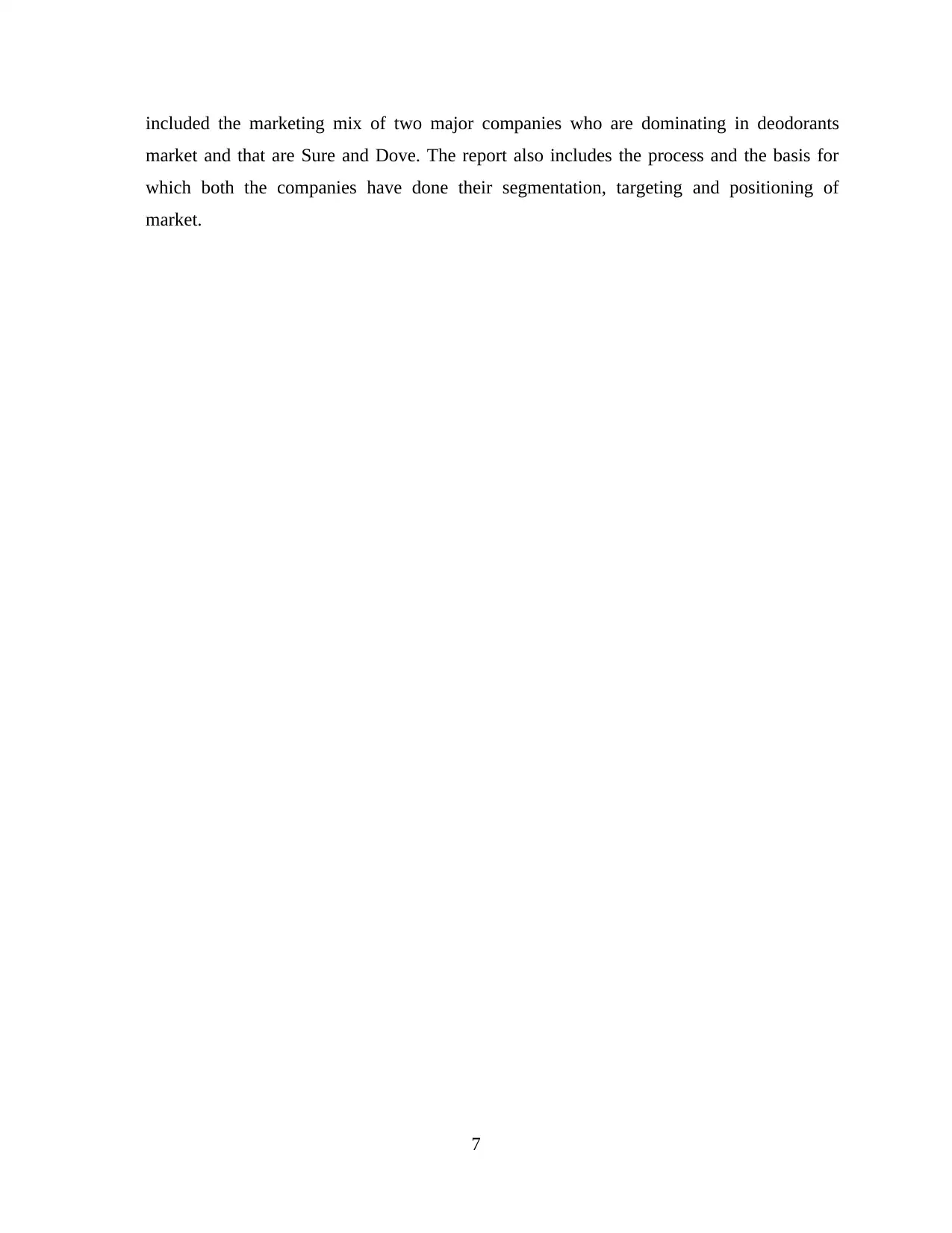
included the marketing mix of two major companies who are dominating in deodorants
market and that are Sure and Dove. The report also includes the process and the basis for
which both the companies have done their segmentation, targeting and positioning of
market.
7
market and that are Sure and Dove. The report also includes the process and the basis for
which both the companies have done their segmentation, targeting and positioning of
market.
7
Paraphrase This Document
Need a fresh take? Get an instant paraphrase of this document with our AI Paraphraser
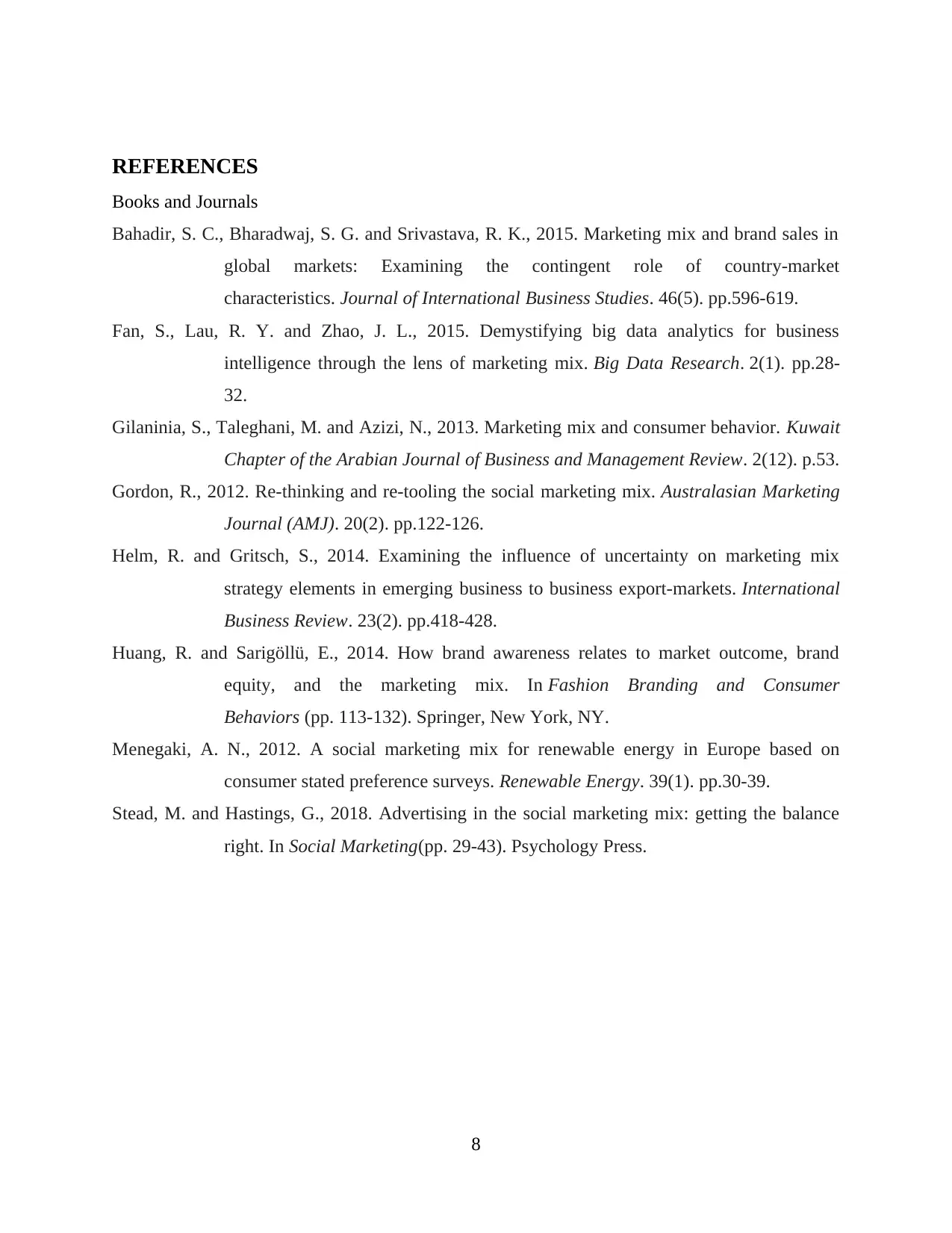
REFERENCES
Books and Journals
Bahadir, S. C., Bharadwaj, S. G. and Srivastava, R. K., 2015. Marketing mix and brand sales in
global markets: Examining the contingent role of country-market
characteristics. Journal of International Business Studies. 46(5). pp.596-619.
Fan, S., Lau, R. Y. and Zhao, J. L., 2015. Demystifying big data analytics for business
intelligence through the lens of marketing mix. Big Data Research. 2(1). pp.28-
32.
Gilaninia, S., Taleghani, M. and Azizi, N., 2013. Marketing mix and consumer behavior. Kuwait
Chapter of the Arabian Journal of Business and Management Review. 2(12). p.53.
Gordon, R., 2012. Re-thinking and re-tooling the social marketing mix. Australasian Marketing
Journal (AMJ). 20(2). pp.122-126.
Helm, R. and Gritsch, S., 2014. Examining the influence of uncertainty on marketing mix
strategy elements in emerging business to business export-markets. International
Business Review. 23(2). pp.418-428.
Huang, R. and Sarigöllü, E., 2014. How brand awareness relates to market outcome, brand
equity, and the marketing mix. In Fashion Branding and Consumer
Behaviors (pp. 113-132). Springer, New York, NY.
Menegaki, A. N., 2012. A social marketing mix for renewable energy in Europe based on
consumer stated preference surveys. Renewable Energy. 39(1). pp.30-39.
Stead, M. and Hastings, G., 2018. Advertising in the social marketing mix: getting the balance
right. In Social Marketing(pp. 29-43). Psychology Press.
8
Books and Journals
Bahadir, S. C., Bharadwaj, S. G. and Srivastava, R. K., 2015. Marketing mix and brand sales in
global markets: Examining the contingent role of country-market
characteristics. Journal of International Business Studies. 46(5). pp.596-619.
Fan, S., Lau, R. Y. and Zhao, J. L., 2015. Demystifying big data analytics for business
intelligence through the lens of marketing mix. Big Data Research. 2(1). pp.28-
32.
Gilaninia, S., Taleghani, M. and Azizi, N., 2013. Marketing mix and consumer behavior. Kuwait
Chapter of the Arabian Journal of Business and Management Review. 2(12). p.53.
Gordon, R., 2012. Re-thinking and re-tooling the social marketing mix. Australasian Marketing
Journal (AMJ). 20(2). pp.122-126.
Helm, R. and Gritsch, S., 2014. Examining the influence of uncertainty on marketing mix
strategy elements in emerging business to business export-markets. International
Business Review. 23(2). pp.418-428.
Huang, R. and Sarigöllü, E., 2014. How brand awareness relates to market outcome, brand
equity, and the marketing mix. In Fashion Branding and Consumer
Behaviors (pp. 113-132). Springer, New York, NY.
Menegaki, A. N., 2012. A social marketing mix for renewable energy in Europe based on
consumer stated preference surveys. Renewable Energy. 39(1). pp.30-39.
Stead, M. and Hastings, G., 2018. Advertising in the social marketing mix: getting the balance
right. In Social Marketing(pp. 29-43). Psychology Press.
8
1 out of 8
Related Documents
Your All-in-One AI-Powered Toolkit for Academic Success.
+13062052269
info@desklib.com
Available 24*7 on WhatsApp / Email
![[object Object]](/_next/static/media/star-bottom.7253800d.svg)
Unlock your academic potential
Copyright © 2020–2025 A2Z Services. All Rights Reserved. Developed and managed by ZUCOL.





